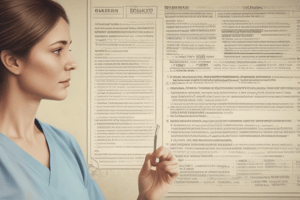Podcast
Questions and Answers
What is an appropriate practice when documenting a patient's condition?
What is an appropriate practice when documenting a patient's condition?
- Chart a patient's change in condition and actions taken (correct)
- Chart vague descriptions of patient changes
- Alter the record if asked by a physician
- Use patient instead of the patient's name
Why is it important to be timely in charting?
Why is it important to be timely in charting?
- It allows for advance note-taking on future patient actions
- Late entries can diminish the accuracy of the information (correct)
- It eliminates the need for correcting spelling errors
- Timely entries ensure better compliance with regulations
What should you do if you find an error in your charting?
What should you do if you find an error in your charting?
- Ask a colleague to correct it for you
- Correct it according to agency requirements (correct)
- Make a note of it on a separate document
- Ignore it since it was already submitted
Which of the following actions is permissible when documenting?
Which of the following actions is permissible when documenting?
Which statement is NOT a guideline for effective documentation?
Which statement is NOT a guideline for effective documentation?
What should be avoided in documentation regarding patient information?
What should be avoided in documentation regarding patient information?
What is a consequence of charting in advance of events?
What is a consequence of charting in advance of events?
What is considered a best practice in documentation?
What is considered a best practice in documentation?
Flashcards are hidden until you start studying
Study Notes
Documentation Do's
- Chart changes in a patient's condition and document actions taken to address the changes.
- Review nurses' notes before providing care to identify potential changes in a patient's condition.
- Document care in a timely manner. Late documentation is preferred to no documentation, although accuracy may be compromised with increased time between care and documentation.
- Use precise, objective, and factual descriptions in documentation.
- Correct any errors in documentation according to agency guidelines.
- Ensure correct spelling in all documentation.
- Record any teaching provided to patients.
- Document patients' exact words using quotation marks.
Documentation Don'ts
- Do not chart care in advance of providing it.
- Avoid the use of vague terminology in documentation.
- Do not chart for another person.
- Do not use "patient" instead of the patient's name in documentation.
- Do not alter the medical record, even when requested by a physician.
- Do not document assumptions or subjective opinions that might reflect bias. For example, avoid using terms like "complainer."
Studying That Suits You
Use AI to generate personalized quizzes and flashcards to suit your learning preferences.





